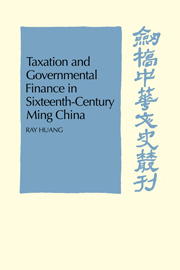Book contents
- Frontmatter
- Contents
- List of figures
- List of tables
- Preface by D. C. Twitchett
- Acknowledgements
- A note on weights and measures
- The Ming emperors
- Map of Ming provinces
- 1 Fiscal organization and general practices
- 2 The heritage of the sixteenth century and major fiscal problems
- 3 The land tax—(i) Tax structure
- 4 The land tax—(ii) Tax administration
- 5 The salt monopoly
- 6 Miscellaneous incomes
- 7 Financial management
- 8 Concluding observations
- List of abbreviations
- Appendixes
- Notes to the text
- Bibliography
- Glossary index
- General index
1 - Fiscal organization and general practices
Published online by Cambridge University Press: 04 August 2010
- Frontmatter
- Contents
- List of figures
- List of tables
- Preface by D. C. Twitchett
- Acknowledgements
- A note on weights and measures
- The Ming emperors
- Map of Ming provinces
- 1 Fiscal organization and general practices
- 2 The heritage of the sixteenth century and major fiscal problems
- 3 The land tax—(i) Tax structure
- 4 The land tax—(ii) Tax administration
- 5 The salt monopoly
- 6 Miscellaneous incomes
- 7 Financial management
- 8 Concluding observations
- List of abbreviations
- Appendixes
- Notes to the text
- Bibliography
- Glossary index
- General index
Summary
Most governmental institutions under the Ming preserved certain features reminiscent of previous dynasties, the T'ang, Sung and Yüan, yet at the same time developed distinctive characteristics of their own. The dynasty's fiscal administration was no exception. Such Ming practices as the employment of supervising secretaries as fiscal auditors, the organization of six ministries, the circulation of government notes, the utilization of the Grand Canal as a trunkline connecting the north and the south, the trading of tea for horses with nomadic groups, and bartering salt under governmental monopoly for military supplies in the frontier region, were clearly copied from earlier dynasties. On the other hand the Ming administration saw more concentration of power in the emperor's hand, smaller administrative overheads, a greater reliance on agrarian sources for state income and a stricter control over maritime trade which virtually committed China to a state of limited seclusion.
The imitation of the past was not totally unjustified. In fiscal matters all dynasties in post-T'ang China faced the same fundamental problems. To secure the durability of the empire, imperial control over the nation's financial resources had to be firm and thorough. Yet the empire's vastness and its regional diversities worked against a policy of centralization, as did pre-modern methods of transport and communications. The gap between aims and the limited available means of achieving them was not easily bridged. In these circumstances it was not surprising that all dynasties tended to draw on past experience.
- Type
- Chapter
- Information
- Publisher: Cambridge University PressPrint publication year: 1975

